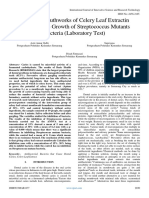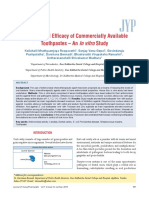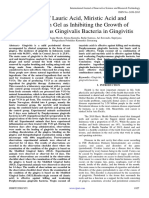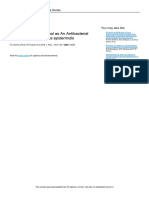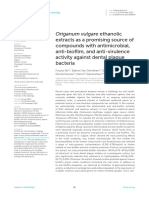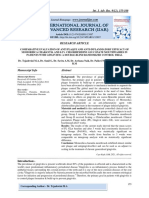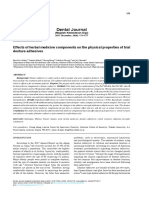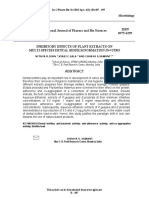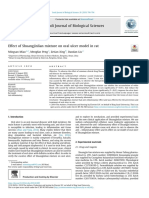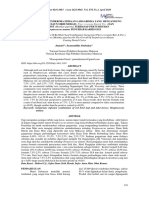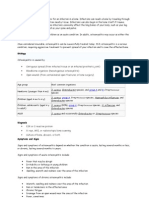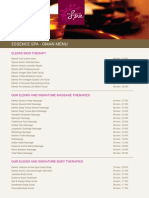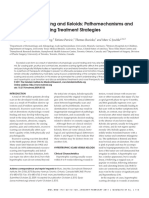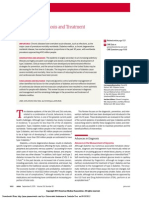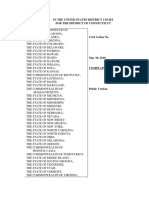Professional Documents
Culture Documents
Potential Use Beecomb Gel (Trigona SP) in The Healing Process of Periodontitis (Wistar Experimental Animal Research)
Original Title
Copyright
Available Formats
Share this document
Did you find this document useful?
Is this content inappropriate?
Report this DocumentCopyright:
Available Formats
Potential Use Beecomb Gel (Trigona SP) in The Healing Process of Periodontitis (Wistar Experimental Animal Research)
Copyright:
Available Formats
Volume 8, Issue 5, May – 2023 International Journal of Innovative Science and Research Technology
ISSN No:-2456-2165
Potential Use Beecomb Gel (Trigona Sp) in the
Healing Process of Periodontitis
(Wistar Experimental Animal Research)
Rismawati
Poltekkes Kemenkes Semarang
Supriyana Endah Aryati Eko Ningtyas
Poltekkes Kemenkes Semarang Poltekkes Kemenkes Semarang
Abstract:- Periodontitis is an advanced disease of The main cause of dental and oral diseases such as
untreated gingivitis which results in the destruction of the gingivitis (inflammation of the gums) and periodontitis
periodontal tissue which includes the gingiva, alveolar (inflammation of the supporting tissues of the teeth).3Plaque is
bone and cementum which is characterized by pocket a soft deposit that is clinically yellow-gray in color attached to
formation. Periodontitis can be treated by providing the surface of the teeth and hard surfaces in the oral cavity
therapy with antibiotics and anti-inflammatory drugs. consisting of 70-80% microorganisms and an intercellular
Honeycomb (Trigona Sp) contains flavonoids, phenolic matrix consisting of organic and inorganic materials derived
acids and their esters, which act as anti-inflammatory from saliva, gingival crevicular fluid and bacterial product.
agents. The purpose of this study was to prove that Porphyromonas gingivalis bacteria were found in 85.75% of
honeycomb gel (Trigona Sp) as an alternative material subgingival plaque which is the beginning of periodontitis.4
has an effect on changes in clinical conditions in
periodontitis in Wistar rats. This type of research is true Gingivitis that is not treated will develop into
experiment and design using posttest only with control periodontitis, to prevent periodontitis can be done by
group design. Consisting of the 10% beehive gel (trigona maintaining oral hygiene by preventing the formation of
sp) intervention group, the positive control group was dental plaque buildup by brushing teeth, and removing
10% povidone iodine and distilled water. Observations calculus. Periodontitis can be treated by providing mechanical
were made for 7 days. The variables studied were gingival therapy such as scaling and root planing which is supported
inflammation using index gingiva and periodontal pocket. by the administration of antibiotics and anti-inflammatory
This study showed that there were inflammatory changes drugs.5
in Wistar rats with periodontitis, based on the results of
the unpaired test the honeycomb gel (p=0.001), povidone Anti-inflammatory agents must meet several
iodine (p=0.002) and distilled water (p=0.003) groups had requirements, including not being toxic to the human body but
significant differences. As for changes in periodontal lethal to microorganisms, having a broad antibacterial
pockets, based on the results of the unpaired test in the spectrum that can kill microbes, low resistance, namely the
honeycomb gel group (p=0.009), povidone iodine lack of ability of bacteria to become resistant to bacterial
(p=0.001) and distilled water (p=0.001), there was a agents and have substantivity. The drug that is often used to
significant difference in each treatment group. prevent inflammation is povidone iodine and is also
commonly used as a wound medicine. However, for long-
Keywords:- Honeycomb Gel (Trigona Sp), Inflammation, term use it can cause side effects such as allergic reactions.
Periodontitis, Wistar Rats. Honeycomb (Trigona Sp) contains flavonoids which act as
anti-inflammatory agents.6
I. INTRODUCTION
Particles contained in beehives are propolis which act as
Dental and mouth problems that many people experience pharmacological are flavanoids, phenolic acids and their
in general include cavities, gingivitis, and tartar. According to esters, these parts effectively affect microorganisms, parasites
WHO statistical data, 98% of people in the world have a and infections. Honeycomb (Trigona Sp) has the ability as a
history of inflammatory diseases of the oral cavity, most of mitigation exercise, immunomodulator, and antitumor and can
which are inflammatory periodontal diseases and are the most be used in treating infections.7Apart from minimizing the side
common oral diseases after caries.1RISKESDAS 2018 data effects of using drugs that contain chemicals, the use of herbal
shows the percentage of periodontitis cases in Indonesia is ingredients is also due to the use of ingredients from nature
74.1%.2Dental plaque is the culprit. because they are easier to obtain and from an economic point
of view they are also more economical so that they can be
used by all groups of people.
IJISRT23MAY760 www.ijisrt.com 1525
Volume 8, Issue 5, May – 2023 International Journal of Innovative Science and Research Technology
ISSN No:-2456-2165
The gel provides fast drug release and is highly which are often used as objects of clinical research because of
biocompatible with a lower risk of inflammation and side their different anatomical and physiological structures. has
effects and is easy to use, besides that the use of gel similarities with the structure of human anatomy and
dermatologically has several beneficial properties such as physiology.11Because of that the researchers used honeycomb
non-greasy, easily removed, easily spreadable, thixotropic, gel using a concentration of 10% in wistar rats.
emollient, non- coloring, and soluble or water soluble and
compatible with some excipients.8 9 II. RESEARCH METHOD
Honeycomb gel with a concentration of 10% has This research uses true experimental research, namely
antibacterial ability so it is effective in inhibiting the real research by controlling all external variables that affect
formation of biofilms which are the places for the the course of the research. The design of this study uses a
development of porphyromonas gingivalis bacteria, because it posttest only with control group design. Sampling was carried
has a bacteriostatic effect by inhibiting the synthesis of out using Simple Random Sampling.12 Subjects in this study
macromolecules of bacterial cells and causing damage to the were divided into two groups, namely the treatment group and
bacterial cell membrane due to its lipophilic nature.10Wistar the control group. The treatment group will be given
rats are widely used as laboratory animals because they have honeycomb gel (trigona sp) while the positive control group
advantages such as a relatively short life cycle, large number will be given povidone iodine and the negative control group
of offspring per birth, high variation in traits, easy to handle, will be given distilled water.
and production properties and characteristics of wistar rats
III. RESULTS AND DISCUSSION
Table 1. Treatment tests on days 1, 3 and 7 of the 10% honeycomb gel group, the povidone iodine group and the distilled water
group (Gingival Index)
Treatment Day Mann withney kruskall-wallis
Sig. Sig Sig
Honeycomb gel (Trigona Sp) 10% 1 and 3 0.009
3 and 7 0.018 0.001
1 and 7 0.008
Povidone Iodine 10% 1 and 3 0.002
3 and 7 0.003 0.002 0.570
1 and 7 0.008
Aqudest 1 and 3 0.002
3 and 7 0.003 0.003
1 and 7 0.001
Based on the Mann-Withney unpaired test, inflammation For the Kruskall-Wallis test to compare the three
was measured using the Gingival Index in rats with variables or groups in each treatment day it has a p value
periodontitis which could be observed to have a p value <0.05 <0.05 so that there is also a significant difference between
so it can be concluded that there was a significant difference treatment days in the honeycomb gel (trigona sp) group,
between days 1 and 3, days 3 and 7 and days 1 and 7 in each povidone iodine treatment days and in aquades treatment
of the three different treatment groups. days. Meanwhile, to compare the 3 treatments, the value of p>
0.05 was obtained so that there was a change but there was no
significant difference from the treatment of the three groups.
Table 2. Treatment tests on days 1, 3 and 7 of the 10% honeycomb gel group, the povidone iodine group and the distilled water
group (periodontal pocket)
Treatment Day To- Mann-Withney Kruskall-Wallis
Sig. Sig. Sig
Honeycomb gel (Trigona Sp) 1 and 3 0.001
10% 3 and 7 0.008 0.009
1 and 7 0.006
Povidone Iodine 10% 1 and 3 0.004
3 and 7 0.002 0.001 0.379
1 and 7 0.008
Aqudest 1 and 3 0.001
3 and 7 0.001 0.001
1 and 7 0.007
IJISRT23MAY760 www.ijisrt.com 1526
Volume 8, Issue 5, May – 2023 International Journal of Innovative Science and Research Technology
ISSN No:-2456-2165
Based on the unpaired Mann Withney test, periodontal encouraging the migration of various cells including
pockets measured using a periodontal probe in rats with fibroblasts in the wound area.15 Honeycomb (Trigona Sp) has
periodontitis obtained a p value <0.05 so that there was a the ability as a mitigation, immunomodulatory, and antitumor
significant difference between treatment days 1 and 3, on days exercise and can be used in treating infections, the mechanism
3 and 7 and on days 1 and 7 on each -each three different of propolis' antimicrobial activity is based on inhibiting the
treatments. motility and activity of different bacterial enzymes and
weakening the stability of the cytoplasmic membrane. 16
In the unpaired Kruskall-Wallis test in each of the 3
groups, a p value <0.05 was obtained so that on each In line with this, a study conducted by Nila Kusuma also
treatment day in the honeycomb gel (trigona sp) group, on the showed that the content of beehives in the form of propolis is
povidone iodine treatment day and on the aquades treatment effective in reducing inflammation levels thereby curing mild
day there was a significant difference. Meanwhile, to compare gingivitis, other ingredients of propolis, especially B-complex
all 3 treatment groups, a p> 0.05 value was obtained so that vitamins, will help absorb minerals the body needs such as
there was a change but there was no significant difference iron, zinc, copper, chrome silizium, vanadium, manganese,
between the three groups. and sixteen essential amino acids needed for cell
regeneration.17
The active ingredient contained in the trigona sp beehive
is propolis. Propolis consists of ingredients namely Effectiveness of honeycomb gel (Trigona Sp) on changes
flavonoids, phenols, aromatic compounds, amino acids, in periodontal pocket depth in periodontitis
minerals, vitamins A, E and B complex. Nearly 50% of Based on the mann-withney unpaired test to see changes
propolis is a flavonoid compound consisting of acetin, in the state of the periodontal pocket using 10% honeycomb
quercetin, naringenin and galangin. Based on the components gel (trigona sp) obtained values on days 1 and 3 (p=0.001),
of these compounds, honeycomb extract can be used as an days 3 and 7 (p=0.008), days 1 and 7 (0.006). The value
anti-inflammatory. The mechanism of action of honeycomb (p<0.05) indicated that there was a significant difference and
extract (Trigona Sp) as an anti-inflammatory is by reducing the administration of honeycomb gel (trigona sp) was
the number of inflammatory mediators, namely effective in changing the periodontal pocket in a better
macrophages.13Another content of propolis, namely apigenin direction.
and tt-farnesol, causes a decrease in the amount of
polysaccharides in the biofilm of microorganisms. Apigenin Then an unpaired Kruskall-Wallis test was performed to
and tt-farnesol will affect one of the polysaccharides in the compare the effect of the three treatments on changes in the
biofilm which functions for attachment to the cell surface, depth of the periodontal pocket. Honeycomb gel (trigona sp)
thereby stopping the formation of biofilms.14 had a value (p=0.009), the povidone iodine and distilled water
groups had the same value (p=0.001). Value (p <0.05) so that
Effectiveness of honeycomb gel (Trigona Sp) to reduce this means that the three treatments have an influence on
gingival inflammation in periodontitis changes in the periodontal pocket of Wistar rats who
Based on a paired test to see changes in the condition of experience periodontitis.
gingival inflammation every day using the Mann-Withney test
showed that 10% honeycomb gel (trigona sp) obtained values The decrease in pocket depth can be caused by the work
on days 1 and 3 (p=0.009), on days 3 and 7 (p=0.018) ) and on of the honeycomb content in the form of propolis which
days 1 and 7 (p=0.008), the value (p<0.05) which means that directly eliminates the microbes in the periodontal pocket. So
the administration of 10% beehive gel (trigona sp) had a that one of the key factors in periodontal therapy is to first
significant difference and was effective in reducing gingival eliminate the causative factor, namely periodontopathogenic
inflammation in Wistar rats with periodontitis. Then, the bacteria. In accordance with the results of studies from
Kruskall-Wallis test was carried out to compare each various researchers who stated that the main characteristic of
treatment group. 10% honeycomb gel (trigona sp) had a value propolis is its ability as an antimicrobial agent.18This is in line
(p=0.001), the positive control group in the form of povidone with research conducted by Hetty Noveilga. The results of this
iodine had a value (p=0.002) and the negative control group in study show that propolis gel can inhibit the growth of the
the form of distilled water had a value (p=0.003) where the Porhpyromonas gingivalis bacteria. The content of flavonoids
value (p<0.0. in propolis has antibacterial activity through inhibiting the
function of bacterial DNA so that the ability of bacterial
Honeycomb gel (trigona Sp) as an alternative material replication and translation is inhibited. The biological activity
that is safe, non-toxic and effective. The active ingredient of the flavonoid compounds in propolis against bacteria is
contained in beehives (trigona sp) is propolis which acts as a carried out by damaging the cytoplasmic membrane of the
pharmacological agent, namely flavanoids, phenolic acids and bacteria.19
their esters, these parts effectively affect microorganisms,
parasites and infections. Reaction as an anti-inflammatory and The changes that occur in the transition from a normal
antioxidant from honeycomb (trigona sp) through inhibition gingival sulcus to a periodontal pocket are related to
of NF kβ activation and downregulation of pro-inflammatory differences in the number of bacterial cells in dental plaque.
enzymes, cyclooxygenase-2 by reducing inflammatory The periodontal ligament connects the tooth to the jawbone
mediators produced through the arachidonic acid pathway, and also supports the tooth in its socket and absorbs the loads
reducing swelling of blood vessels in connective tissue, applied to the tooth. Periodontal disease causes loss of
IJISRT23MAY760 www.ijisrt.com 1527
Volume 8, Issue 5, May – 2023 International Journal of Innovative Science and Research Technology
ISSN No:-2456-2165
attachment of the periodontal tissues and cementum exposed study on male wistar rats (rattus norvegicus). Dentine.
to the oral environment. Periodontal tissue damage was 2019;III(1):10–6.
significantly mediated by MMP levels. TIMP regulates MMP [6]. Wachidah, Nurlailatul R. Effect of Forest Bee (Apis
by inhibiting proteinase enzymes and blocking MMP dorsata) Honey Solution Concentration on Growth
activation autocatalytically.20In line with another study, a Inhibition of Porphyromonas gingivalis Dominant
study by AE Zaenal Hasan, the results showed that there was Gingivitis (in vitro study). 2016.
antibacterial activity of honeycomb extract (trigona sp) [7]. Murtikasari M. The Effect of 10% Propolis Gel and
containing propolis on the growth of Salmonella sp. The Near Infrared Phototherapy on Post Curettage Wound
group of compounds identified in the honeycomb are Healing (Study on sparague dawley rats in terms of
flavonoids and tannins, indicating that these compounds are collagen fiber density). Semarang: Sultan Agung
responsible for the antibacterial activity.21 University; 2021. 6 p.m.
[8]. Novitasari AIM, Indraswary R, Pratiwi R. Effect of
IV. CONCLUSIONS AND SUGGESTIONS Application of 10% Duck Eggshell Membrane Extract
Gel on Density of Collagen Fibers in Gingival Wound
Administration of 10% beehive gel (trigona sp) proved Healing Process. ODONTO Dent J. 2017;4(1):13.
to be effective and had an effect on changes in clinical [9]. Jadhav MS, Jadhav MS, Agrawal YS, Goyal SM. A
conditions in periodontitis in Wistar rats, with changes in Review Article On Topical Gel For The Treatment Of
gingival inflammation and changes in the depth of the Skin Fungal Infection. 2019;06(05):10117–29.
periodontal pocket towards the healing process. [10]. Kurniawan H, Widyastuti W, Hutapea ME. The
Administration of honeycomb gel (trigona sp) 10% effectiveness of the combination of Moringa oleifera
proved effective against inflammatory changes in extract and propolis on Porphyromonas gingivalis
periodontitis conditions in Wistar rats. The mechanism of biofilms compared to 0.7% tetracycline. Dent J
action of honeycomb gel (trigona sp) reduces (Dentistry Magazine). 2021;54(2):63.
inflammatory mediators, namely macrophages. [11]. Nugroho RA. Recognizing Mice as Laboratory
Administration of honeycomb gel (trigona sp) 10% Animals. Samarinda: Mulawarman University Press;
proved to be effective and had an effect on changes in 2018.
periodontal pocket depth in periodontitis conditions in [12]. Notoatmojo S. Health Research Methodology Third
Wistar rats. The transition from a normal gingival sulcus Edition. Jakarta: Rineka Pustaka; 2005.
to a periodontal pocket is related to differences in the [13]. Saidah M, Oktiani BW, Taufiqurrahman I. The Effect
number of bacterial cells. OfKelulut Propolis Flavonoids (Trigona spp) Extract
On Macrophage Cell Number In Periodontitis (In Vivo
Suggestions for future research are to conduct a Study In Male Wistar Rate (Rattus novergicus)
histopathophysiological test to find out more about the Gingiva). Dentino J Dentist. 2020;5(1):28.
pathophysiology related to healing and indicators of [14]. Asdar, Cindrakori HN. Inhibitory Power of Propolis Gel
inflammation, and it is expected to carry out an organoleptic from South Sulawesi on the Growth of Porphyromonas
test on honeycomb gel (trigona sp) which includes taste test, Gingivalis Bacteria. J B-Dent. 2015;2(2):101–9.
color test, odor test, texture test, test pH and viscosity test. [15]. Aidina LN. The Effect of Gel Administration on
Fibroblast Cell Count in Male Wistar Rats Induced by
REFERENCES Periodontitis. 2019.
[16]. Okińczyc P, Paluch E, Franiczek R, Widelski J,
[1]. WHO. Oral health : achieving better oral health as part Wojtanowski KK, Mroczek T, et al. Antimicrobial
of the universal health coverage and non-communicable activity of Apis mellifera L. and Trigona sp. propolis
disease agendas towards 2030. Who [Internet]. from Nepal and its phytochemical analysis. Biomed
2020;(December):1–6. Available from: Pharmacother. 2020;129(June).
https://www.who.int/news-room/fact-sheets/detail/oral- [17]. Kasuma N. Propolis Toothpaste as The Initial Therapy
health of Mild Gingivitis. J Science Farm Clinic [Internet].
[2]. Republic of Indonesia Ministry of Health. Basic Health 2016;1(1):89–94. Available from:
Research Results 2018. Indonesian Ministry of Health. http://jsfkonline.org/index.php/jsfk/article/view/16
2018;53(9):1689–99. [18]. Asdar. Effects of Application of Trigona Propolis Gel
[3]. A'yun Q, Fatmasari D, Hendrartini J. Pediatric Caries as Adjunctive Therapy in Periodontal Pockets Review
Predictor Software Based on Child Factors, Mother's of Clinical Effects d Matrix and Metalloproteinase-8
Behavior, and UKGS. Maj. Dentistry Indonesia. Levels. Makassar Hasanuddin University; 2017.
2015;1(1):68. [19]. Cindrakori HN. The Effectiveness of Propolis Trigona
[4]. Dwipriastuti D, Putranto RR,ANGKAi W. Differences sp Extract on the Growth of Porphyromonas
in the Effectiveness of 0.2% Chlorhexidine Gluconate Bacteriagingivalis. Hasanuddin University. 2017;
with Green Tea. ODONTO Dent J. 2017;4:50–4. [20]. Abdurrohman MMS, Putranto RR. Metronidazole Gel
[5]. Tamara A, Oktiani BW, Taufiqurrahman I. Effect of Effect on Rats With Bacteria-Induced Periodontitis.
kelulut propolis flavonoid extract (G.thoracica) on the ODONTO Dent J. 2020;7(1):48.
number of neutrophil cells in periodontitis (in vivo [21]. Hasan A, Artika I, Fatoni A, Haryanto B. Antibacterial
Activity Of Propolis Trigona Spp. From Bukjttinggi
West Sumatra Against Salmonella Sp. 2019;55–9.
IJISRT23MAY760 www.ijisrt.com 1528
You might also like
- <i> Trichoderma</i>: <i> Ganoderma </i> Disease Control in Oil Palm: A ManualFrom Everand<i> Trichoderma</i>: <i> Ganoderma </i> Disease Control in Oil Palm: A ManualNo ratings yet
- 1 PB PDFDocument6 pages1 PB PDFAl Bukhari SubulussalamNo ratings yet
- Potential Mouthworks of Celery Leaf Extractin Inhibiting The Growth of Streptococcus Mutants Bacteria (Laboratory Test)Document5 pagesPotential Mouthworks of Celery Leaf Extractin Inhibiting The Growth of Streptococcus Mutants Bacteria (Laboratory Test)International Journal of Innovative Science and Research TechnologyNo ratings yet
- Sensitivity Difference of Streptococcus Viridans On 35% Piper Betle Linn Extract and 10% Povidone Iodine Towards Recurrent Apthous StomatitisDocument7 pagesSensitivity Difference of Streptococcus Viridans On 35% Piper Betle Linn Extract and 10% Povidone Iodine Towards Recurrent Apthous StomatitisAhmad FadhilNo ratings yet
- Antimicrobial Efficacy of Commercially Available Toothpastes - An in Vitro StudyDocument7 pagesAntimicrobial Efficacy of Commercially Available Toothpastes - An in Vitro StudybiswasblrNo ratings yet
- Antibacterial Activity of Water Hyacinth (Eichhornia Crassipes) Leaf Extract Against Bacterial Plaque From Gingivitis PatientsDocument6 pagesAntibacterial Activity of Water Hyacinth (Eichhornia Crassipes) Leaf Extract Against Bacterial Plaque From Gingivitis PatientsRAKERNAS PDGI XINo ratings yet
- Potential of Lauric Acid, Miristic Acid and Combination Gel As Inhibiting The Growth of Porphyromonas Gingivalis Bacteria in GingivitisDocument9 pagesPotential of Lauric Acid, Miristic Acid and Combination Gel As Inhibiting The Growth of Porphyromonas Gingivalis Bacteria in GingivitisInternational Journal of Innovative Science and Research TechnologyNo ratings yet
- Journal of Dentistry: A.M.L. Pedersen, M. Darwish, J. Nicholson, M.I. Edwards, A.K. Gupta, D. Belstrøm TDocument6 pagesJournal of Dentistry: A.M.L. Pedersen, M. Darwish, J. Nicholson, M.I. Edwards, A.K. Gupta, D. Belstrøm TVina NuranisyahNo ratings yet
- Comparative Evaluation of Indigenous Traditionally Used Herbal Tooth Sticks Datun and Toothpaste in Cleaning of Mouth MicrofloraDocument15 pagesComparative Evaluation of Indigenous Traditionally Used Herbal Tooth Sticks Datun and Toothpaste in Cleaning of Mouth MicrofloranavinlewisNo ratings yet
- 3851 5553 1 SM PDFDocument5 pages3851 5553 1 SM PDFdoraemonNo ratings yet
- Firyanto 2019 J. Phys. Conf. Ser. 1295 012034Document6 pagesFiryanto 2019 J. Phys. Conf. Ser. 1295 012034RimaNo ratings yet
- In Vitro Antimicrobial Activity of Thymus Vulgaris Essential Oil Against Major Oral PathogensDocument7 pagesIn Vitro Antimicrobial Activity of Thymus Vulgaris Essential Oil Against Major Oral PathogensHamza GaaloulNo ratings yet
- Aceite de Coco PeriodontalDocument8 pagesAceite de Coco PeriodontalErick PiñerosNo ratings yet
- Flavonoid propolis extract's effect on neutrophil cells in periodontitisDocument7 pagesFlavonoid propolis extract's effect on neutrophil cells in periodontitisviena mutmainnahNo ratings yet
- Fmicb 13 999839Document24 pagesFmicb 13 999839Miyyada AichaouiNo ratings yet
- Plants: Effect of Propolis Paste and Mouthwash Formulation On Healing After Teeth Extraction in Periodontal DiseaseDocument12 pagesPlants: Effect of Propolis Paste and Mouthwash Formulation On Healing After Teeth Extraction in Periodontal DiseaseSalsabila Tri YunitaNo ratings yet
- Keywords: Eleutherine Bulbosa, Antibacterial, Mouthwash: SubstanceDocument4 pagesKeywords: Eleutherine Bulbosa, Antibacterial, Mouthwash: SubstanceInternational Journal of Innovative Science and Research TechnologyNo ratings yet
- 26 Vol. 8 Issue 2 Feb 2017 IJPSR RA 7029Document3 pages26 Vol. 8 Issue 2 Feb 2017 IJPSR RA 7029jtbkedulyxpxabeiceNo ratings yet
- Journal Homepage: - : IntroductionDocument6 pagesJournal Homepage: - : IntroductionIJAR JOURNALNo ratings yet
- Impact of A Terbinafine-Florfenicol-Betamethasone Acetate Otic Gel On The Quality of Life of Dogs With Acute Otitis Externa and Their Owners 2017Document9 pagesImpact of A Terbinafine-Florfenicol-Betamethasone Acetate Otic Gel On The Quality of Life of Dogs With Acute Otitis Externa and Their Owners 2017Evandro D'OrnellasNo ratings yet
- Characteristics of An Alternative Antibacterial Biomaterial For Mouthwash in The Absence of AlcoholDocument6 pagesCharacteristics of An Alternative Antibacterial Biomaterial For Mouthwash in The Absence of Alcoholsaila salsabilaNo ratings yet
- En PDFDocument6 pagesEn PDFRamadhanu SuwondoNo ratings yet
- EOS - Volume 33 - Issue June 2008 - Pages 63-72Document10 pagesEOS - Volume 33 - Issue June 2008 - Pages 63-72Osama GamilNo ratings yet
- D 0342015021Document7 pagesD 0342015021IOSR Journal of PharmacyNo ratings yet
- Dental Journal: Effects of Herbal Medicine Components On The Physical Properties of Trial Denture AdhesivesDocument7 pagesDental Journal: Effects of Herbal Medicine Components On The Physical Properties of Trial Denture Adhesivesanon_442420071No ratings yet
- Souissi 2019Document7 pagesSouissi 2019rini anggi aristaNo ratings yet
- The Spray Effect of Peronema Canescens Jack As A Disinfectant Against The Growth of Staphylococcus Aureus On The Surface of Alginate MoldsDocument4 pagesThe Spray Effect of Peronema Canescens Jack As A Disinfectant Against The Growth of Staphylococcus Aureus On The Surface of Alginate MoldsInternational Journal of Innovative Science and Research TechnologyNo ratings yet
- Zhang2017 EugenolDocument7 pagesZhang2017 EugenolSri WahyuniNo ratings yet
- Inhibitory Effects of Plant Extracts On Multi-Species Dental Biofilm Formation In-VitroDocument9 pagesInhibitory Effects of Plant Extracts On Multi-Species Dental Biofilm Formation In-VitroahmicphdNo ratings yet
- Shuangjinlian Mixture Effect on Oral UlcersDocument5 pagesShuangjinlian Mixture Effect on Oral Ulcersmeltwithsnow163.comNo ratings yet
- 沙特3分河南大鼠溃疡 PDFDocument5 pages沙特3分河南大鼠溃疡 PDFmeltwithsnow163.comNo ratings yet
- 沙特3分河南大鼠溃疡 PDFDocument5 pages沙特3分河南大鼠溃疡 PDFmeltwithsnow163.comNo ratings yet
- Effects of Fluoride and Epigallocatechin Gallate On Soft-Drink-Induced Dental Erosion of Enamel and Root DentinDocument7 pagesEffects of Fluoride and Epigallocatechin Gallate On Soft-Drink-Induced Dental Erosion of Enamel and Root DentinDaniwulanNo ratings yet
- Acta BiomaterialiaDocument12 pagesActa Biomaterialiafaten emadNo ratings yet
- 3611-Article Text-10164-1-10-20201121Document6 pages3611-Article Text-10164-1-10-20201121ravishankar potluriNo ratings yet
- Versatility of Aloe Vera in Dentistry-A ReviewDocument5 pagesVersatility of Aloe Vera in Dentistry-A ReviewNurul Khairiyah IINo ratings yet
- بحث نور وتقى بعد اضافاتDocument10 pagesبحث نور وتقى بعد اضافاتtuqa abdul kareemNo ratings yet
- Control of growth Streptococcus mutans isolated from saliva and dental cariesDocument11 pagesControl of growth Streptococcus mutans isolated from saliva and dental cariesmaira.myra19No ratings yet
- Efektivitas Antimikroba Sediaan Gargarisma Yang Mengandung Kombinasi Daun Sirih Merah (Daun Mint (Menthae Piperita) Terhadap PertumbuhanDocument8 pagesEfektivitas Antimikroba Sediaan Gargarisma Yang Mengandung Kombinasi Daun Sirih Merah (Daun Mint (Menthae Piperita) Terhadap PertumbuhanLinda NurjanahNo ratings yet
- Efektivitas Antimikroba Sediaan Gargarisma Yang Mengandung Kombinasi Daun Sirih Merah (Daun Mint (Menthae Piperita) Terhadap PertumbuhanDocument8 pagesEfektivitas Antimikroba Sediaan Gargarisma Yang Mengandung Kombinasi Daun Sirih Merah (Daun Mint (Menthae Piperita) Terhadap PertumbuhanAsriany FitriNo ratings yet
- Gingipain Periodontitis DogDocument5 pagesGingipain Periodontitis Dogvioleta.enachescu-1No ratings yet
- Jatropha and Snail Slime Inhibit Strep MutansDocument17 pagesJatropha and Snail Slime Inhibit Strep Mutansninda medianaNo ratings yet
- Cita 12Document9 pagesCita 12Michael CaiminaguaNo ratings yet
- Pengaruh Xylitol Pada Pertumbuhan Bakteri S MutansDocument9 pagesPengaruh Xylitol Pada Pertumbuhan Bakteri S MutansAsriDianSariNo ratings yet
- Aggregatibacter Actinomycetemcomitans: Daya Hambat Ekstrak Propolis Trigona SP Terhadap Pertumbuhan BakteriDocument9 pagesAggregatibacter Actinomycetemcomitans: Daya Hambat Ekstrak Propolis Trigona SP Terhadap Pertumbuhan BakteriDavid Restu Prasetia ManikNo ratings yet
- Perbandingan Efek Bakterisidal Ekstrak MengkuduDocument6 pagesPerbandingan Efek Bakterisidal Ekstrak MengkuduOcie Puteri RiauNo ratings yet
- Development and Evaluation of Dental Fil 639ae860Document26 pagesDevelopment and Evaluation of Dental Fil 639ae860Sasi DaranNo ratings yet
- Effect of Honey in Preventing Gingivitis and Dental Caries in Patients Undergoing Orthodontic TreatmentDocument7 pagesEffect of Honey in Preventing Gingivitis and Dental Caries in Patients Undergoing Orthodontic TreatmentdwiajaNo ratings yet
- Herbs - The Natural Alternative To Treat The Periodontal DiseasesDocument5 pagesHerbs - The Natural Alternative To Treat The Periodontal DiseasesIJAR JOURNALNo ratings yet
- Archana DeviDocument5 pagesArchana DeviTsubakiHariuNo ratings yet
- ABSTARKDocument19 pagesABSTARKohmyfrngkNo ratings yet
- 11 11 PBDocument61 pages11 11 PBNur Adry HamdianyNo ratings yet
- Experimental Treatment of Recurrent Otitis Externa: Open Veterinary Journal, (2015), Vol. 5 (1) : 38-41Document4 pagesExperimental Treatment of Recurrent Otitis Externa: Open Veterinary Journal, (2015), Vol. 5 (1) : 38-41Christian ThamNo ratings yet
- Inhibition of Oral Pathogens and Collagenase Activity by Seaweed ExtractsDocument8 pagesInhibition of Oral Pathogens and Collagenase Activity by Seaweed ExtractsDwi FadhilahNo ratings yet
- 2020 Effect of EGCGDocument5 pages2020 Effect of EGCGPT DAPNo ratings yet
- Antibacterial Effects of 70 Ethanol and Water ExtrDocument7 pagesAntibacterial Effects of 70 Ethanol and Water ExtrAyu RafaniaNo ratings yet
- Formulation and Evaluation of Antimicrobial Mucoadhesive Dental Gel of Aerial Root of Ficus Benghalensis L To Enhance The Therapeutic Activity Using Clove OilDocument7 pagesFormulation and Evaluation of Antimicrobial Mucoadhesive Dental Gel of Aerial Root of Ficus Benghalensis L To Enhance The Therapeutic Activity Using Clove OilInternational Journal of Innovative Science and Research TechnologyNo ratings yet
- Formulation and Evaluation of Nail Lacquer Containing Anti Fungal Griseofulvin For The Treatment of OnychomycosisDocument13 pagesFormulation and Evaluation of Nail Lacquer Containing Anti Fungal Griseofulvin For The Treatment of OnychomycosisInternational Journal of Innovative Science and Research TechnologyNo ratings yet
- EFFECTIVE OE TREATMENTDocument6 pagesEFFECTIVE OE TREATMENTEvandro D'OrnellasNo ratings yet
- 1 PBDocument10 pages1 PBRieza Zulfahmi TaftazaniNo ratings yet
- Cyber Security Awareness and Educational Outcomes of Grade 4 LearnersDocument33 pagesCyber Security Awareness and Educational Outcomes of Grade 4 LearnersInternational Journal of Innovative Science and Research TechnologyNo ratings yet
- Factors Influencing the Use of Improved Maize Seed and Participation in the Seed Demonstration Program by Smallholder Farmers in Kwali Area Council Abuja, NigeriaDocument6 pagesFactors Influencing the Use of Improved Maize Seed and Participation in the Seed Demonstration Program by Smallholder Farmers in Kwali Area Council Abuja, NigeriaInternational Journal of Innovative Science and Research TechnologyNo ratings yet
- Parastomal Hernia: A Case Report, Repaired by Modified Laparascopic Sugarbaker TechniqueDocument2 pagesParastomal Hernia: A Case Report, Repaired by Modified Laparascopic Sugarbaker TechniqueInternational Journal of Innovative Science and Research TechnologyNo ratings yet
- Smart Health Care SystemDocument8 pagesSmart Health Care SystemInternational Journal of Innovative Science and Research TechnologyNo ratings yet
- Blockchain based Decentralized ApplicationDocument7 pagesBlockchain based Decentralized ApplicationInternational Journal of Innovative Science and Research TechnologyNo ratings yet
- Unmasking Phishing Threats through Cutting-Edge Machine LearningDocument8 pagesUnmasking Phishing Threats through Cutting-Edge Machine LearningInternational Journal of Innovative Science and Research TechnologyNo ratings yet
- Study Assessing Viability of Installing 20kw Solar Power for the Electrical & Electronic Engineering Department Rufus Giwa Polytechnic OwoDocument6 pagesStudy Assessing Viability of Installing 20kw Solar Power for the Electrical & Electronic Engineering Department Rufus Giwa Polytechnic OwoInternational Journal of Innovative Science and Research TechnologyNo ratings yet
- An Industry that Capitalizes off of Women’s Insecurities?Document8 pagesAn Industry that Capitalizes off of Women’s Insecurities?International Journal of Innovative Science and Research TechnologyNo ratings yet
- Visual Water: An Integration of App and Web to Understand Chemical ElementsDocument5 pagesVisual Water: An Integration of App and Web to Understand Chemical ElementsInternational Journal of Innovative Science and Research TechnologyNo ratings yet
- Insights into Nipah Virus: A Review of Epidemiology, Pathogenesis, and Therapeutic AdvancesDocument8 pagesInsights into Nipah Virus: A Review of Epidemiology, Pathogenesis, and Therapeutic AdvancesInternational Journal of Innovative Science and Research TechnologyNo ratings yet
- Smart Cities: Boosting Economic Growth through Innovation and EfficiencyDocument19 pagesSmart Cities: Boosting Economic Growth through Innovation and EfficiencyInternational Journal of Innovative Science and Research TechnologyNo ratings yet
- Parkinson’s Detection Using Voice Features and Spiral DrawingsDocument5 pagesParkinson’s Detection Using Voice Features and Spiral DrawingsInternational Journal of Innovative Science and Research TechnologyNo ratings yet
- Impact of Silver Nanoparticles Infused in Blood in a Stenosed Artery under the Effect of Magnetic Field Imp. of Silver Nano. Inf. in Blood in a Sten. Art. Under the Eff. of Mag. FieldDocument6 pagesImpact of Silver Nanoparticles Infused in Blood in a Stenosed Artery under the Effect of Magnetic Field Imp. of Silver Nano. Inf. in Blood in a Sten. Art. Under the Eff. of Mag. FieldInternational Journal of Innovative Science and Research TechnologyNo ratings yet
- Compact and Wearable Ventilator System for Enhanced Patient CareDocument4 pagesCompact and Wearable Ventilator System for Enhanced Patient CareInternational Journal of Innovative Science and Research TechnologyNo ratings yet
- Air Quality Index Prediction using Bi-LSTMDocument8 pagesAir Quality Index Prediction using Bi-LSTMInternational Journal of Innovative Science and Research TechnologyNo ratings yet
- Predict the Heart Attack Possibilities Using Machine LearningDocument2 pagesPredict the Heart Attack Possibilities Using Machine LearningInternational Journal of Innovative Science and Research TechnologyNo ratings yet
- Investigating Factors Influencing Employee Absenteeism: A Case Study of Secondary Schools in MuscatDocument16 pagesInvestigating Factors Influencing Employee Absenteeism: A Case Study of Secondary Schools in MuscatInternational Journal of Innovative Science and Research TechnologyNo ratings yet
- The Relationship between Teacher Reflective Practice and Students Engagement in the Public Elementary SchoolDocument31 pagesThe Relationship between Teacher Reflective Practice and Students Engagement in the Public Elementary SchoolInternational Journal of Innovative Science and Research TechnologyNo ratings yet
- Diabetic Retinopathy Stage Detection Using CNN and Inception V3Document9 pagesDiabetic Retinopathy Stage Detection Using CNN and Inception V3International Journal of Innovative Science and Research TechnologyNo ratings yet
- An Analysis on Mental Health Issues among IndividualsDocument6 pagesAn Analysis on Mental Health Issues among IndividualsInternational Journal of Innovative Science and Research TechnologyNo ratings yet
- Implications of Adnexal Invasions in Primary Extramammary Paget’s Disease: A Systematic ReviewDocument6 pagesImplications of Adnexal Invasions in Primary Extramammary Paget’s Disease: A Systematic ReviewInternational Journal of Innovative Science and Research TechnologyNo ratings yet
- Harnessing Open Innovation for Translating Global Languages into Indian LanuagesDocument7 pagesHarnessing Open Innovation for Translating Global Languages into Indian LanuagesInternational Journal of Innovative Science and Research TechnologyNo ratings yet
- Exploring the Molecular Docking Interactions between the Polyherbal Formulation Ibadhychooranam and Human Aldose Reductase Enzyme as a Novel Approach for Investigating its Potential Efficacy in Management of CataractDocument7 pagesExploring the Molecular Docking Interactions between the Polyherbal Formulation Ibadhychooranam and Human Aldose Reductase Enzyme as a Novel Approach for Investigating its Potential Efficacy in Management of CataractInternational Journal of Innovative Science and Research TechnologyNo ratings yet
- The Utilization of Date Palm (Phoenix dactylifera) Leaf Fiber as a Main Component in Making an Improvised Water FilterDocument11 pagesThe Utilization of Date Palm (Phoenix dactylifera) Leaf Fiber as a Main Component in Making an Improvised Water FilterInternational Journal of Innovative Science and Research TechnologyNo ratings yet
- The Impact of Digital Marketing Dimensions on Customer SatisfactionDocument6 pagesThe Impact of Digital Marketing Dimensions on Customer SatisfactionInternational Journal of Innovative Science and Research TechnologyNo ratings yet
- Dense Wavelength Division Multiplexing (DWDM) in IT Networks: A Leap Beyond Synchronous Digital Hierarchy (SDH)Document2 pagesDense Wavelength Division Multiplexing (DWDM) in IT Networks: A Leap Beyond Synchronous Digital Hierarchy (SDH)International Journal of Innovative Science and Research TechnologyNo ratings yet
- Advancing Healthcare Predictions: Harnessing Machine Learning for Accurate Health Index PrognosisDocument8 pagesAdvancing Healthcare Predictions: Harnessing Machine Learning for Accurate Health Index PrognosisInternational Journal of Innovative Science and Research TechnologyNo ratings yet
- The Making of Object Recognition Eyeglasses for the Visually Impaired using Image AIDocument6 pagesThe Making of Object Recognition Eyeglasses for the Visually Impaired using Image AIInternational Journal of Innovative Science and Research TechnologyNo ratings yet
- Formulation and Evaluation of Poly Herbal Body ScrubDocument6 pagesFormulation and Evaluation of Poly Herbal Body ScrubInternational Journal of Innovative Science and Research TechnologyNo ratings yet
- Terracing as an Old-Style Scheme of Soil Water Preservation in Djingliya-Mandara Mountains- CameroonDocument14 pagesTerracing as an Old-Style Scheme of Soil Water Preservation in Djingliya-Mandara Mountains- CameroonInternational Journal of Innovative Science and Research TechnologyNo ratings yet
- Ferlin PDFDocument1 pageFerlin PDFRomeo ReyesNo ratings yet
- The Herbal of Dioscorides The Greek Book TwoDocument180 pagesThe Herbal of Dioscorides The Greek Book TwoShari Cook100% (2)
- Ignatavicius Medical Surgical Nursing 6eDocument10 pagesIgnatavicius Medical Surgical Nursing 6erunnermn100% (1)
- A Clinical Study of EpistaxisDocument5 pagesA Clinical Study of EpistaxisHadi PrasetyoNo ratings yet
- Individual Education PlanDocument9 pagesIndividual Education PlanPenelopeNo ratings yet
- Bronchiolitis in ChildrenDocument16 pagesBronchiolitis in ChildrenNym Angga Santosa100% (1)
- OSTEOMYELITISDocument14 pagesOSTEOMYELITISKristine Alejandro0% (1)
- Menu Oman PDFDocument2 pagesMenu Oman PDFcolleen860% (1)
- GPST Stage 2Document34 pagesGPST Stage 2Chiranjeevi Kumar EndukuruNo ratings yet
- Principles of Electrosurgery - MegadyneDocument21 pagesPrinciples of Electrosurgery - Megadynemihaesdenis8575100% (1)
- Crystal HealingDocument39 pagesCrystal Healingsoniabellani100% (5)
- Hypertrophic ScarsDocument13 pagesHypertrophic ScarsNovita NingtyasNo ratings yet
- Jurnal Internasional FlavonoidDocument8 pagesJurnal Internasional FlavonoidindahgamaNo ratings yet
- Case Study On Pneumonia (Real)Document28 pagesCase Study On Pneumonia (Real)Gleevyn Dela Torre86% (7)
- General Consent For Dental TreatmentDocument1 pageGeneral Consent For Dental TreatmentSreekanth KrishnamurthyNo ratings yet
- Experimental & Quasi Experimental DesignDocument70 pagesExperimental & Quasi Experimental DesignSathish Rajamani100% (1)
- Prometric Tests Question BookDocument8 pagesPrometric Tests Question Bookaims14375% (12)
- Thiamazole PretreatmentDocument7 pagesThiamazole PretreatmentWendy WijayaNo ratings yet
- Dos 523 Treatment Planning ProjectDocument11 pagesDos 523 Treatment Planning Projectapi-504593245No ratings yet
- Manual Therapy TechniquesDocument30 pagesManual Therapy TechniquesNistara Singh Chawla100% (1)
- Idiopathic Hypersomnia Its All in Their HeadDocument2 pagesIdiopathic Hypersomnia Its All in Their HeadSambo Pembasmi LemakNo ratings yet
- REVERSAL OF DENTAL FLUOROSIS CLINICAL STUDYDocument12 pagesREVERSAL OF DENTAL FLUOROSIS CLINICAL STUDYDEEPAK SAININo ratings yet
- Craniofacial Fibrous DysplasiaDocument15 pagesCraniofacial Fibrous DysplasiassleosNo ratings yet
- Diabetes Advances in Diagnosis and TreatmentDocument11 pagesDiabetes Advances in Diagnosis and TreatmentAbi GarciaNo ratings yet
- CONCHEM q4 m4 Anticancerdrugs-V3Document24 pagesCONCHEM q4 m4 Anticancerdrugs-V3NovaNo ratings yet
- The Trauma of FreudDocument318 pagesThe Trauma of Freudrelsinger100% (5)
- Maternal and Child HealthDocument72 pagesMaternal and Child Healthannamargie07100% (3)
- Drugs Affecting BPDocument36 pagesDrugs Affecting BPm1k0eNo ratings yet
- 31 Day Dumbbell Bodyweight WorkoutDocument3 pages31 Day Dumbbell Bodyweight WorkoutSuvaneel MoulickNo ratings yet
- Gdms Complaint Redacted Public VersionDocument524 pagesGdms Complaint Redacted Public VersionWGMENo ratings yet


